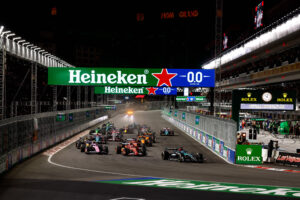The 2017 Formula 1 testing at Barcelona is half-way to being complete. It initially appears that Mercedes and Ferrari are the teams to beat, with Red Bull and Renault not far behind.
But take what little we learned from three days of dry running and one pointless day of wet running with a large pinch of salt. The times will certainly not tell the entire story. If anything, testing is even less likely to give us a true running order than usual.
Why 2017 Formula 1 Testing may not Shape the Story of the Season
F1 is braced for what could well be the most extreme development race in over a decade. The token system used for power unit development has been scrapped, allowing for as much exploration on that side as logistically possible. In addition, the new aerodynamic regulations have opened up a few areas of interest (namely the sidepods and the floor) and there will likely be an incredible amount of development here.
Several teams have already confirmed that the ‘launch’ version of the car will not be the same version which turns up at the first race. The sidepod and engine cover areas are two areas in particular where parts seem fairly easily interchangeable, so expect to see a lot of changes between now and the Australian Grand Prix.
This means that the fastest car at this test may not necessarily be the fastest car come Melbourne. The fastest car at Melbourne may not be the fastest car when F1 returns to Barcelona in a few months. The fastest car at the Spanish Grand Prix may well not be the fastest car after the summer break, and the fastest car there may not be the fastest car at the season finale at Abu Dhabi. Seeing how this develops will be fascinating across the season.
The key to success this season may not be starting the year with the fastest package. What may be better is having a package with a lot of room for improvement as the year goes on. Hitting the upper limits of a car’s potential early on may result in falling down the order at the sharp-end of the season. Ferrari turned up in 2012 with a solid base package but with little pace, but by the return to Europe, they managed to unlock the potential of their car, whereas McLaren turned up with a very quick car that year, but could only finish third in the championship.
We also have teams blatantly holding cards very close to their chest. The fact that the fastest car in the speed trap, Sauber, is the only one powered by a 2016 unit would imply that the rest of the field is yet to unleash close to the full horsepower of their equipment. Perhaps understandably, getting any gremlins out of the way is a priority, so maybe we will see the wick turned up a bit in the second test.
One team in particular has turned up with a package which appears very basic on the face of it. Red Bull should suit the regulation change arguably better than anybody else, yet the initial thought of the RB13 was somewhat underwhelming and simplistic. However, design guru Adrian Newey will almost certainly have things up his sleeve for the start of the season and onwards. To a degree, similar could be said of the Renault team.
Each of the ten cars have their own interesting quirks. What we see on the Mercedes or the Ferrari could well end up appearing on other cars if these designs fit with the philosophy of the cars. The T-wing is something which has sprouted up everywhere for example, and teams will continue to experiment with different solutions.
Despite this season not having an engine freeze, it would be surprising to see a season like 2009, where one team (Brawn) started as the dominant favourites, only for four or five teams to surpass them during the season. The situation is vastly different to then, as we do not have the likes of KERS coming in, and the team which was Brawn now has full Mercedes backing and resources. However, this does not mean that a gap which may exist at Melbourne cannot be drastically reduced.
The development of the power unit will perhaps be more crucial this year than in the previous years of this new turbocharged, hybrid era of F1. Renault’s Cyril Abiteboul has anticipated a step of three tenths of a second improvement from the unit alone over winter, with a similar step expected across the season. Of course, not all upgrades may work, and reliability will be as critical as always.
Another major factor could well be tyres. New, harder tyres supplied by Pirelli this year may be difficult to get on with, as we saw back in that 2012 season. Teams may be off the pace at a round because they are not able to get the tyres into their operating window. This helped contribute to the record seven different winners in the first seven races of that year.
In the event that we do have a dominant force at the start of the season, especially if it is Mercedes, then do not give up hope on the new regulations just yet. 20 races will tell a lot of stories as the year progresses, and the development race will hopefully result in a fascinating championship battle emerging over the year.
We don’t know who is truly fastest right now. We certainly don’t know who will be quickest when the final chequered flag of the year falls. We do know that the rate of development this season will be at levels not seen for many years, and we can hope for a thrilling season-long battle as a result of this.






